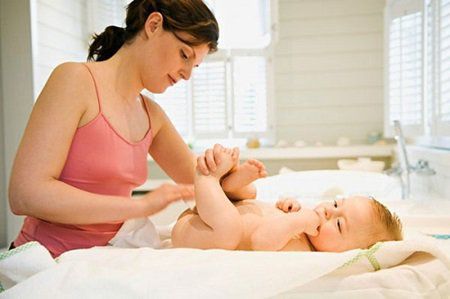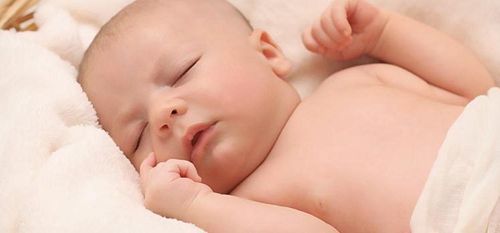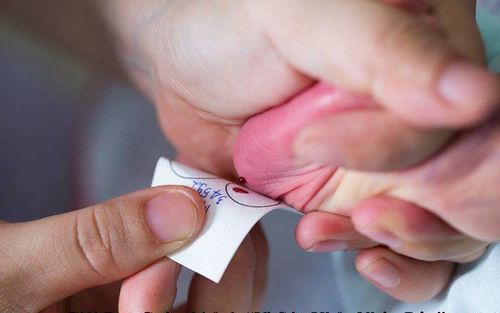This is an automatically translated article.
The article was professionally consulted by Specialist Doctor I Bui Thi Ha - Pediatrician - Neonatologist - Department of Pediatrics - Neonatology - Vinmec Ha Long International General Hospital. He has over 11 years of experience working in the field of Pediatrics - Neonatology and has strengths in the field of pediatric cardiopulmonary resuscitation, neonatology, access to diagnosis and treatment, neonatal diseases such as premature birth, neonatal diseases, and neonatal diseases. membranes, respiratory failure, neonatal sepsis.Proper and adequate care for babies not only begins after birth, but parents need to prepare all aspects from the prenatal period, especially in terms of knowledge and psychology. For a mother giving birth for the first time, there are many doubts about how to properly care for a newborn.
1. Instructions on how to hold a newborn
Before picking up the baby, the mother needs to let the baby know that she will hold the baby. Look and talk to your baby lovingly, gently slipping your hands under her head, shoulders and bottom to gently pick her up. This helps the baby not to startle or cry because he is suddenly lifted from the bed.When holding the baby for the first time, the mother is often a little awkward but be gentle, after a few days, you will know what position the baby likes to be held the most. Each baby will like to be held in a separate position, some babies like to carry their shoulders, some babies like to be held on their backs...
Trắc nghiệm: Thế nào là trẻ sơ sinh đủ tháng?
Đặc điểm bên ngoài của trẻ sơ sinh đủ tháng được thể hiện qua các tiêu chuẩn như: Cân nặng, chiều dài và hình thể. Theo dõi bài trắc nghiệm dưới đây sẽ giúp các bậc cha mẹ hiểu thế nào là trẻ sơ sinh đủ tháng, qua đó có thể đánh giá tổng trạng sức khỏe và sự phát triển của bé yêu nhà mình.The following content is prepared under supervision of Thạc sĩ, Bác sĩ y khoa, Ma Văn Thấm , Nhi , Phòng khám Đa khoa Quốc tế Vinmec Dương Đông(Phú Quốc)
2. Instructions for taking care of babies while feeding and sleeping
Breastfeeding should be started as early as the first hour after birth. The first drops of colostrum are not really abundant but contain many nutrients, which are essential for the baby. It is necessary to choose a feeding position so that both mother and baby are comfortable, can breastfeed in a sitting position or lying down.Sitting position: the mother sits comfortably, her back can rest so that the muscles of the neck and lower back are not stretched, causing fatigue and back pain. The baby is held firmly and lifted by the mother's arms. An extra pillow can be added below to make lifting the baby lighter and easier.

Child lying close to the mother: The mother lies on her side, the lower thigh rests on the pillow, the upper leg is bent at the knee. Place the baby on his side facing the mother so that the baby's mouth is close to the mother's lower chest. The mother uses the lower arm to support the baby's head to press the baby's mouth to the breast. After the mother and baby are in the feeding position, the mother cleans the nipple and nipple and uses her thumb and index finger to hold the part near the nipple. Gently bring the nipple to the baby's lips to stimulate the sucking reflex, when the baby opens his mouth, squeeze close and bring the nipple into the baby's mouth.
Need to make sure the baby latches on correctly: The baby's mouth is wide open, the whole areola is attached, the chin is close to the mother's breast, the lower lip is brought out. The baby sucks regularly, the cheeks are tight, the mother can hear the sound of swallowing milk. If the baby is not full, feed the other breast. Breastfeed day and night on demand, usually every 2 to 3 hours, for 15 to 30 minutes each time. If your baby sleeps too much, wake him up and feed him every 3 hours. If the baby does not feed for 2 times or the button reflex is too weak, or vomiting ... then the baby should see a doctor immediately.
When reheating breast milk, do not boil it on the stove, but warm the milk in the container by immersing the whole bottle in a cup of warm water so that the temperature in the breast milk bottle does not exceed 40 degrees Celsius. If the breast milk is frozen, can be thawed by putting the bottle of milk in a cup of boiling water, then shaking well and making sure the temperature is warm enough.
It is necessary for the baby to sleep in a clean, cool and quiet room so that the baby can sleep easily. For a full-term, healthy newborn, the appropriate room temperature is about 28 degrees Celsius. Do not let the room temperature be too low because it can cause the baby to catch a cold or the high temperature will make the baby sweat easily and cause itching. snoring, irritability, poor sleep.

Mothers can put the baby in the crib and gently rock it, sing a soft lullaby or play soft music to make it easier for the baby to fall asleep. The baby should be avoided to sleep in the prone position, if the baby is on the stomach, it must be carefully monitored.
3. How to wash and clean babies
3.1 How to change diapers for babies Mothers can give babies cloth diapers or diapers or use both diapers alternately to save money. When choosing diapers for your baby, you should choose an appropriate size, with anti-rashes and itching properties. If you let your child use cloth diapers, choose one with soft, absorbent cotton material.Should change the baby's diaper immediately after the baby pees or poops. When changing, must clean the baby's anal and genital area with a soft cloth and warm water from front to back. A diaper rash cream or skin protectant should be applied before putting on a new diaper.

3.2 How to bathe a newborn For convenience, it is recommended to use a 2-in-1 baby shampoo to bathe your baby. Before bathing the baby, it is necessary to prepare the following:
Wash your hands thoroughly. Note, when taking care of babies, do not have long nails or wear jewelry with rough or sharp surfaces because they can cause scratches on the baby's skin. Small size towels, large bucket towels, pants shirt, hat, gloves... Gauze, cotton balls, cotton swabs, sterile umbilical cords Physiological saline 0.9%. Before bathing your baby, turn off the fan, turn off the air conditioner, and give the baby a massage. Use clean water mixed with boiling water to bathe the baby. Water with a temperature of about 36 - 38 degrees Celsius (depending on the season) is suitable for bathing children.
If you do not have a thermometer to measure the temperature of the bath water, you can use your elbow to test the bath water for your baby. Note that while bathing the baby, it is advisable to talk affectionately with the child so that the child feels the love.
When everything is ready, proceed to bathe the baby according to the following steps:
The mother puts the baby on the bed or flat surface, uses a cotton ball soaked in physiological saline to wipe the baby's eyes from the inside out. Use a soft washcloth to clean your baby's nostrils. Wash the baby's face. Pick up the baby and wash the baby's hair: The thumb and ring finger of the hand holding the baby gently press the 2 earlobes close to the ear to prevent water from entering the baby's ear, use the other hand to wet the baby's hair with a towel (gauze) . Next, take a little shampoo and apply it to your baby's hair, then rinse it clean, and dry your baby's head with a towel. When the baby has not shed the umbilical cord, should use a soft towel to wipe the baby's body to avoid wetting the umbilical cord. If you want to bathe your baby, put the baby in a basin of water with a little shower gel mixed in to bathe, but then need to clean the baby's navel area to avoid infection. Put the child in another tub of water to bathe again. Put the child on a bed or flat surface lined with a large towel, dry and warm the child with a towel. Use physiological saline to clean the eyes and nose, then use a cotton ball to wipe it from the inside out. Use a cotton swab/cotton to clean the outside of the child's ear. Avoid letting the tip of the saline bottle or eye drops touch your child's eyes or nose. Put physiological saline on the tongue gauze to clean the baby's mouth. Use a cotton ball to clean the water around the navel, use a cotton swab soaked in physiological saline to dry the navel. Should keep the navel open, avoid wrapping bandages right away to help the navel dry quickly and fall off faster. Put on a shirt, diaper, gloves and feed the baby immediately if the baby is in need. If you want to trim your baby's fingernails and toenails, cut them after he's finished bathing. At this time, the baby is comfortable and the nails are very soft and easy to cut. In addition, you can also wait for the baby to fall asleep and then cut. Regular trimming of fingernails and toenails will help keep the baby's fingernails and toenails from being scratched, limiting the situation where the nail scratches hook into the glove, causing pain, discomfort or the baby hurting himself.

3.3 Care of the umbilical cord for the newborn In newborns, the umbilical cord is an open wound, which is easy to get infected if the mother does not take good care of it. This is a very dangerous condition, if not detected and treated in time, can cause complications of blood infection for the child.
The care of the umbilical cord for the newborn needs to be done daily and cleaned according to the following steps:
Before taking care of the baby's umbilical cord, the mother needs to wash her hands thoroughly, disinfect her hands with 90 degree alcohol. Gently remove your baby's umbilical cord and gauze. Observe the umbilicus and the area around the umbilicus for redness, pus, yellow discharge, bleeding, foul odor or any other abnormalities. Wipe the navel with a cotton ball with sterile cooked water, then pat the umbilical cord and umbilical cord area dry. Disinfect the skin around the navel with physiological saline. The navel can be left open or just covered with a thin layer of sterile gauze. Wrap the diaper area below the navel to prevent feces, urine or anything from contaminating the navel area.

Need to monitor and take care of the umbilical cord for the newborn every day. If you detect one of the following signs, take your baby to the pediatrician immediately:
The umbilical cord oozes yellow, has a bad smell or has pus. The umbilicus is bleeding profusely and is difficult to control. The skin around the navel is red and swollen. The navel has buds, protracted oozing. The navel hasn't fallen off even though the baby is 3 weeks old. If you see any abnormal signs in your baby's umbilical cord, you absolutely must not give antibiotics or any medicine to your baby without a doctor's prescription.
4. How to take care of baby's skin
Newborn skin is very sensitive and easily damaged, so baby skin care needs to be focused.
Skin care and the selection of skin care products need to adhere to a few principles:
Avoid contact with irritants Mother choose to buy clothes with soft materials, remove labels . Although the rubbing is light, repeated rubbing can also cause the baby's skin to be scratched, which can easily lead to infection. Use soap made for babies or sensitive skin to wash baby's clothes.
Limit exposure to harmful irritants from the environment Change your baby's diaper right after he pees or poops. Clinically proven mild products should be used to avoid skin irritation. Choose the right diaper for your baby.
Avoiding toxic substances that can affect the baby's eyes Newborns do not have the reflex to close their eyes and excrete tears, so it is necessary to keep them away from cigarette smoke or polluted environments. Use gentle, non-irritating skin and hair care products. Avoid cleaning products that contain alcohol or soaps with strong detergents.
Always keep your baby's skin with proper moisture Dry climates or too much bathing can make baby's skin dehydrated. Mothers should apply lotion on dry or flaky skin for the baby. But not changing diapers regularly (including cloth diapers, diapers) and hot and humid environment can cause skin infections, fungal infections. Every time you change your baby's diaper, you need to clean the diaper area with a mild cleanser and dry the baby.
Limiting the impact on the balance of bacteria residing on the child's skin. Bacterial strains that live on newborn skin are present soon after birth. They rarely cause disease unless the skin has an open wound or the natural acidity of the skin is destroyed. Therefore, it is necessary to keep the umbilical cord stump clean, dry and airy. Bathe your baby with a mild, pH-balanced body wash suitable for baby's skin.

In addition to taking care of newborn babies, parents should pay attention to nutrition to improve the child's resistance. At the same time, add supporting foods containing lysine, essential micro-minerals and vitamins such as zinc, chromium, selenium, B vitamins,... snacks and less digestive problems.
Parents can learn more:
Why do you need to supplement Lysine for your baby?
The role of zinc - Guidelines for reasonable zinc supplementation
Please visit the website Vinmec.com regularly and update useful information to take care of your baby and family.















